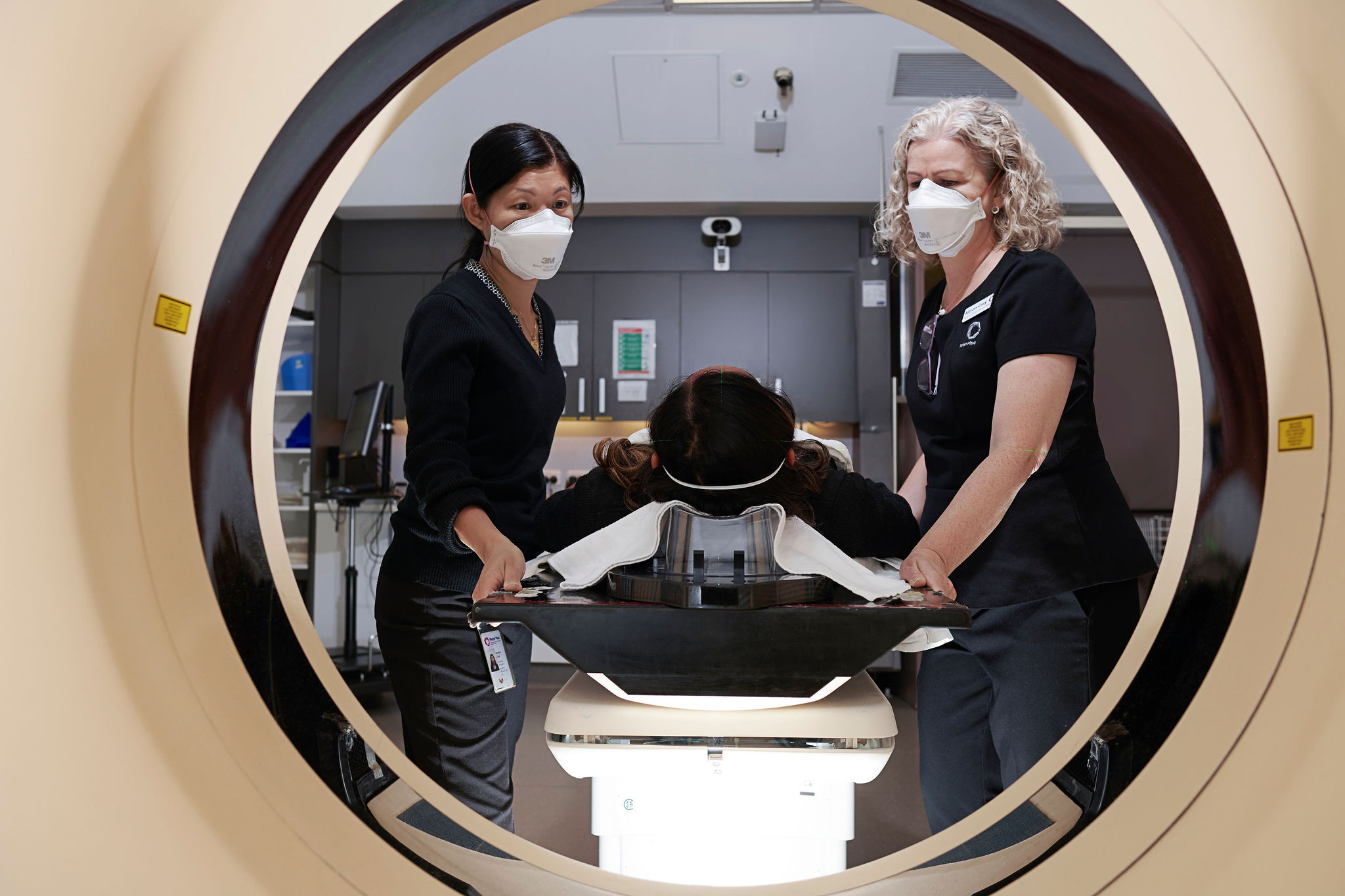Positron Emission Tomography scans give us information not available from other scans, which your doctors can use to help them choose the best treatment. This helps with managing your cancer.
We can also use Positron Emission Tomography scanning to check the effectiveness of treatment. They can also help plan for surgery and radiation therapy.
The PET scanner looks a lot like a CT (Computed Tomography) scanner and is open at both ends.
What the procedure involves
- We will inject a small amount of radioactive solution (radiotracer) into a vein in your hand or arm. The most common radiotracer is 18F-FDG. FDG (fluorodeoxyglucose), which is a sugar compound.
- After this injection, you will need to rest in a bed or recliner chair. You will need to lay down and be quiet for at least an hour (60 minutes). During this time, the radiotracer travels through the body. It is important that you lie still during the resting period. This prevents muscles from taking up the radiotracer. You can watch television or listen to music whilst you rest, but you cannot read a magazine or book.
- After the resting period, the PET scan will begin. You will lie on the scanning bed, which inches through the scanner. The PET scanner will detect the radiation released from the injection. It will use this to create pictures of the inside of your body. The scan will take around half an hour (25-30 minutes), depending on the area of the body we are scanning. You will need to lie as still as possible, to help the technologist get good quality images.
How to prepare for an FDG Positron Emission Tomography scan
Generally, you will need to fast for several hours before the PET scan. This means no eating any food or drinking any liquids with sugars. You can drink plain water during this time. We recommend you drink at least 500mls (half a litre) of water before you arrive for your appointment. Your appointment letter will give specific instructions about when to begin your fast.
Dress in warm, comfortable clothing. It's best if this is without metal items like zips or studs.
You will spend about two to three hours at the PET Centre. Please consider this when parking your car.
You may usually experience pain when lying down for similar periods. If so, we ask that you bring your pain-relief medication with you.
Other Positron Emission Tomography radiotracers
In our department, there are several other PET radiotracers available.
68Ga-tate (Gatate) is a radioactive tracer used to detect some Neuroendocrine tumours (NETs). You do not have to fast for this test, but you need to hydrate. Let our staff know if you are having Octreotide or Somatostatic injections. Please inform us when booking your appointment. Patients should expect to be in the department for two to three hours.
68Ga-PSMA (Prostate-Specific Membrane Antigen) or 18F-PSRare radiotracers used to look at Prostate Cancer. Patients do not need to fast for this scan but must be well hydrated before it. You should plan on being at the PET centre for two to four hours.
18F-FET is useful for looking at primary brain tumours or metastases. Patients do not have to fast for this test, and we recommend you are well hydrated.
Location
Peter MacCallum Cancer Centre
Level 5 (5C), 305 Grattan Street
Melbourne VIC 3000
Contact
- Phone: (03) 8559 5510
- Fax: (03) 8559 5519
- Email: [email protected]
FDG Positron Emission Tomography/CT Scan Preparation Instructions for Patients with Diabetes
If your appointment is not set for early morning, please call the PET Department on 03) 8559 6751. Your blood sugar level will be best between 5-8mmol/L at your appointment time. Please read the following instructions. If you have concerns following them, you can contact us. Otherwise, you can contact your diabetes care provider (endocrinologist or General Practitioner).
Before Scan | Preparation Instructions |
|---|---|
48 hours | Stop Metformin medications 48 hours before your appointment. They can affect the quality of images. Metformin medications include Metformin, Diabex, Diaformin, Formet, Metforbell, Glucohexal, Glucomet, Glucophage, Genrx metformin, and Genepharm metformin. |
24 hours | Stay hydrated and follow diet: Drink plenty of water for 24 hours before. A high-protein and low-carbohydrate diet minimises dietary sugars. High protein diet suggestions: Beef, turkey, pork including bacon, fish, chicken, and eggs Avoid carbohydrate foods: Bread, bagels, cereal, cookies, toast, pasta, crackers, muffins, peanut butter, nuts, fruit, fruit juice, potatoes, candy, rice, cornbread, carrots, beets, chewing gum, mints, cough drops, and sweet soft drinks |
Midnight | Fasting and stop insulin. We ask you to not to eat or drink anything but water from midnight before your appointment time. That includes no food, tea, coffee, juice or chewing gum. You are to stop long and short acting insulin the day of your appointment. You should take the night before as per normal. Insulin can interfere with the uptake of the FDG tracer in your body. Please call us if you are a type 1 diabetic or concerned about not having insulin the morning of your test. |
Day of scan | Your blood sugar level may be lower than normal, or you may have symptoms of hypoglycaemia. If so, treat your low blood sugar in your usual way. Do not let your blood sugar drop that you are unsafe. Please call the PET Department. You can talk with us about rebooking or delaying the appointment once you're stable. Your blood sugars may be above 10mmol/L. If so, we may need to alter your preparation for the scan. This may increase your time in the department by two to four hours. |
Links related to Positron Emission Tomography
Positron emission tomography: How Does It Work?

